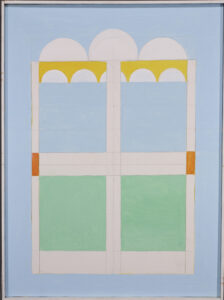
American, born Germany, 1917–1992
N.Y. VII, 1972
Acrylic on canvas
Gift of the Artist in Memory of David Getz, 1975. (1975.162.3)
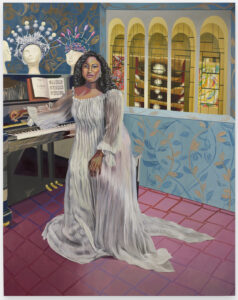
Aliza Nisenbaum
American, born Mexico, 1977
15 Minutes to Curtain, Soprano Angel
Blue (MET Traviata), 2023
Oil on linen
Partial gift of Eric Emmanuel with additional funding provided by The Estelle Reninger Fund, 2024. (2024.7)
This painting is one of three diva portraits that Aliza Nisenbaum created of the sopranos in the Metropolitan Opera’s 2023 rendition of La Traviata. In this project, she was interested in the stars behind the opera’s glamorous production. Here, one of the lead performers, Angel Blue, stands in her dressing room beside her sheet music and piano complete in her makeup and costume. Nisenbaum’s use of shimmering gold and silver, pastel colors, and decorative patterns create a fairytale atmosphere, emphasizing the magical quality of stage production. Her emphasis on Blue behind-the-scenes underscores the creative labor that often goes unseen in theater and opera.
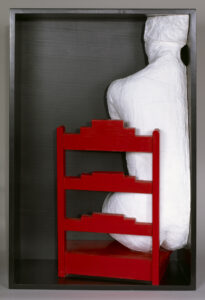
George Segal
American, 1924–2000
Girl on a Chair, 1970
Plaster, wood and polyurethane paint, edition: 150
Published by Editions Alecto Ltd., London, England
Gift of Mr. Richard Roth, 1978. (1978.48)
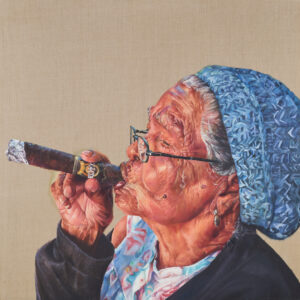
Rigo Peralta
American, born Dominican Republic, 1970
Doña Negra, 2016
Acrylic on linen
Purchase: The Ardath Rodale Art Acquisition Fund, 2019. (2019.7)
This portrait of the artist’s grandmother upends the expected formality of the format and brings its sitter to vibrant life. Analuisa Torres-Peralta was affectionately known as La Negra for her dark skin. In this painting, Doña Negra—at age 94—smokes an Exactus Maduro cigar, made in the Dominican Republic where both she and her grandson were born. The cigar recalls the long history of tobacco growing in the Dominican Republic. It suggests the country’s role in the global economy and references the Indigenous Taino people who cultivated tobacco in the Caribbean islands. The portrait also evokes fond and important memories for the Allentown-based artist, who has said, “It represented an almost sacred ritual to be able to smoke a Dominican cigar with my grandmother.”
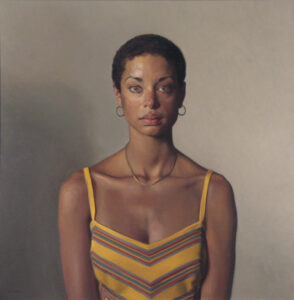
Nelson Shanks
American, 1937–2015
Nancy, 1974
Oil on canvas
Gift of Mr. and Mrs. Franklin D. Crawford, Princeton, New Jersey, 1975. (1975.147)
The founder of a school for realist art in Philadelphia, Nelson Shanks is known for his presidential portraits, including those of Ronald Reagan and Bill Clinton, and his portraits of influential women, such as the first four female justices of the U.S. Supreme Court. Here Shanks lends gravitas to a more personal depiction of an individual woman.
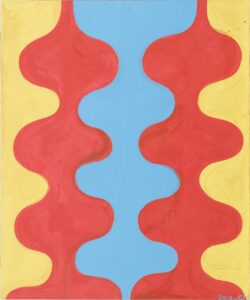
Chris Martin
American painter, born 1954
Like Seven Inches from the Noonday Sun, 2013
Oil on canvas
Gift of the Weissman Family Collection, 2023. (2023.26)
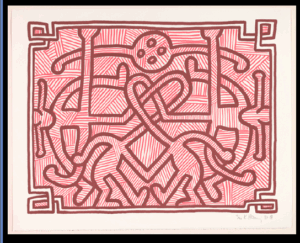
Keith Haring
American, 1958–1990
Chocolate Buddah 2, 1989
Lithograph, edition: 90
Yenna Hill
“I am not a beginning. I am not an end. I am a link in a chain.” – Keith Haring
This print comes from a portfolio that draws inspiration from mandalas, geometric devotional images used in Buddhism and other faiths. Here, Haring borrows the mandala’s symmetrical format, but fills his composition with his signature cartoon-like figures. Their limbs intertwine, forming abstract patterns as well as a central heart.
Haring wanted everyone to feel welcome to find their own meaning in his art. How would you interpret this print?
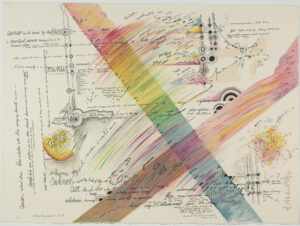
Mary Bauermeister
German, 1934–2023
Esoteric Healing, 1973
Lithograph, edition: 250
Gift of Argosy Partners and Bond Street Partners, 1979. (1979.73.2)
In this print, Mary Bauermeister combined visual poetry with musical rhythm to investigate the connections between spirituality, meditation, and the universe. The text in the lithograph does not present a cohesive narrative; it is instead a “mind map” of the artist’s thoughts on biology, astronomy, and philosophy. Bauermeister hoped that by writing about these topics, she could enter a meditative state and uncover hidden knowledge about the world.
In contrast to her stone assemblage (on the wall behind you), which embraces order and structure, this print plays with improvisation and chaos as the artist contemplates the cosmos.
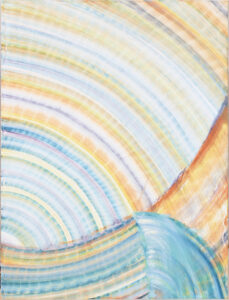
Danielle Riede
American, born 1976
Love in Orange, 2022
Oil with textured gesso on canvas
Gift of Danielle Riede, Courtesy Garvey|Simon NYC, 2023.
(2023.18.2)
Riede lends her experience as a lifelong dancer to her painting, translating movement into gesture on her abstract canvases. Beginning with an intuitive movement off the canvas, such as the arc of an arm, she then records that same movement in paint. She is also inspired by nature’s motion: lava flowing, ocean waves rippling, rays of sunlight streaming.
Riede has developed a special technique to build up texture in works like this one, applying layers of gesso made from calcium carbonate, a material found in eggshells, limestone, and chalk, that behaves much like plaster. The result suggests tidal motion beneath the surface.
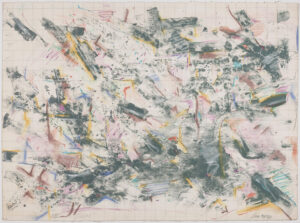
Ricardo Viera
American, born Cuba, 1945–2020
Islas A II, 1973–74
Hand-colored lithograph
Printer: the artist
Gift of Lucille Bunin Askin, 1976. (1976.37)
Although Ricardo Viera immigrated to the United States in 1962, his Cuban identity was always central in his artwork. In the 1970s and 1980s, Viera produced several prints on abstract islas (islands) like the one here. These bold splashes of color imposed onto a grid recall geographical maps of Cuba. The erratic energy of the lines may embody the artist’s turbulent displacement from his home.
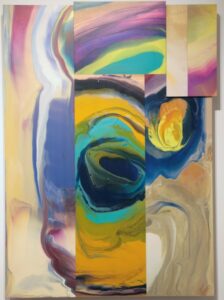
Sam Gilliam
American, 1933–2022
Element, 2008
Acrylic on birch
Gift of Sam Gilliam, 2018. (2018.8)
Sam Gilliam emerged from the Washington, D.C. scene in the mid-1960s to become one of the great innovators of abstract painting. This painting is part of a group of works that Gilliam called “constructed surprises.” He made these paintings by pouring and mixing paint on birch plywood, then cutting apart the boards and reassembling them. This process is related to the revolutionary painting method Gilliam developed in the late 1960s with his so-called Drape paintings, which involved pouring paint onto unstretched canvas and then hanging the canvas as a three-dimensional artwork.
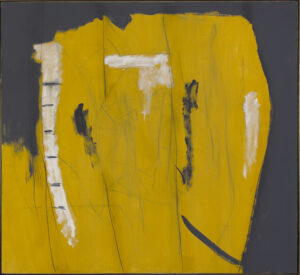
Robert Motherwell
American, 1915–1991
Wall with Graffiti, 1950
Oil and charcoal on linen
Purchase: Gift of Estelle Reninger and Gift of The Dedalus Foundation, 1994. (1994.24)
Robert Motherwell started his paintings with something he called automatic drawing—random marks on the canvas meant to capture the subconscious. He painted Wall with Graffiti when he was completing a mural at a synagogue in Millburn, New Jersey. Although this painting is abstract, some elements suggest Old Testament references: for instance, the long white stroke at the left, covered with horizontal black marks, brings to mind Jacob’s Ladder, stretching from earth to heaven, and the Diaspora is indicated by a scribbled line drawing which suggests the wandering paths of the scattered tribes.

Gunther Gerzso
Mexican, 1913–2000
Geminis, 1961
Oil on Masonite
Gift of Rodale Family, 2017. (2017.25.1)
Gunther Gerzso described his abstract paintings as “landscapes of the spirit.” While he drew inspiration from the European modernists he worked with earlier in his career, by the 1960s he had turned his attention to the power he saw in Mexico’s terrain and pre-Columbian past. Here, his careful brushwork creates layers of earth-toned forms, and suggests hidden depths.
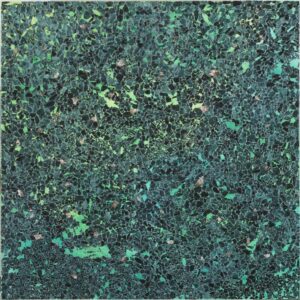
Alteronce Gumby
American, born 1985
Freedom Only Known to Them in
Whispers and Tales, 2022
Gemstones, willemite, calcite, glass and acrylic on panel
Purchase: SOTA Print Fund, 2023. (2023.1)
For this work, Alteronce Gumby assembled glass, minerals, and other unconventional materials into mosaic-like arrangements to evoke swirling galaxies and distant nebulae, a nod to the artist’s lifelong fascination with the cosmos and its infinite possibilities. The minerals used here—green willemite and red calcite—are fluorescent and glow when exposed to ultraviolet (UV) rays.
In only being observable under ultraviolet light—and otherwise undetectable by the human eye—these fluorescing minerals also become an apt metaphor for Gumby’s larger practice, which addresses issues of visibility and invisibility, and aims to challenge our assumptions about color by inviting us to think more expansively about it.
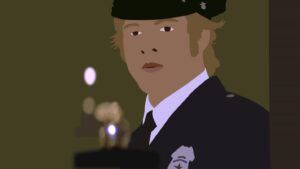
Kota Ezawa
German, active United States, born 1969
The Simpson Verdict, 2002
Video, color, sound, 2 minutes, 48 seconds
The Crime of Art, 2017
Video, color, sound, 2 minutes, 33 seconds
Courtesy of the artist
Kota Ezawa (b. Cologne, Germany, 1969) is known for reworking imagery from popular culture, film, and art history into digital animations. Using a labor-intensive process of digitally hand-drawing each frame of his source material, Ezawa transforms his subjects into flattened, stylized animations that feel at once familiar and strangely distant. By distilling forms and content into their basic visual essence, the artist invites reflection on how images shape our understanding of complex events and frame cultural narratives, prompting us to consider how history is constructed, consumed, and remembered.
The Simpson Verdict (2002) Video, sound, 2:38 min.,
Kota Ezawa’s The Simpson Verdict reimagines one of the most infamous moments in American legal and media history: the 1995 acquittal of O.J. Simpson. Ezawa transforms televised courtroom footage from Simpson’s murder trial into a simplified, cartoon-like aesthetic, distilling emotionally charged reactions into a flattened choreography of movements and tics. In this video, key figures from the televised trial—among them Simpson, defense attorney Johnnie Cochran, and Judge Lance Ito—are rendered in bold outlines and muted colors, their expressions subtly exaggerated yet eerily detached. This stylistic choice creates emotional distance, encouraging viewers to reflect on the trial as spectacle rather than reliving its drama.
The O.J. Simpson case transcended a murder trial, becoming a national obsession that exposed deep fissures in American society—racial, economic, and media-driven. By revisiting this moment, Ezawa interrogates how media representations shape collective memory and shared experiences.
The Crime of Art (Hollywood Edition) (2010)
The Crime of Art (2010) is part of an ongoing series in which Ezawa examines real and fictional art heists. In this video, the artist digitally animates scenes from Hollywood films—including the high-tech theft in Ocean’s Twelve (2004) or the tense gallery break-in from The Thomas Crown Affair (1999)—using his signature minimalist style. Stripping away cinematic glamour, Ezawa reduces these sequences to sleek vignettes, contrasting their high-stakes drama with his detached aesthetic. The work highlights the irony of art theft as performance, transforming thieves into antiheroes and crime into seductive fantasy. Beneath its deadpan humor, Ezawa’s video also deftly critiques the art world’s contradictions, where priceless works are simultaneously venerated and commodified as mere currency in a global market.
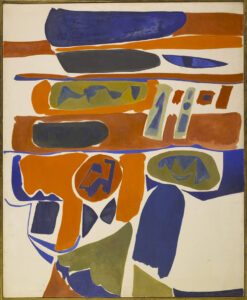
Will Barnet
American, 1911–2012
Clear Day, 1956
Oil on canvas
Gift of Abe Ajay, 1975. (1975.26)
In this landscape depicting Provincetown, Massachusetts, Barnet creates tension between flat, colorful shapes and a white ground. This abstract style—called Indian Space painting—uses Indigenous aesthetics to reimagine European Cubism. The white artists leading this movement believed that drawing inspiration from Native art would set them apart from European artists: Barnet described Indian Space painting as “real American art.” Do you agree? What do you think makes an artwork American?
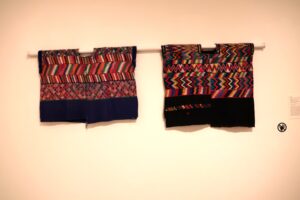
Maya
Made in Tecpán, Guatemala
Huipiles, twentieth century
Cotton plain weave with supplementary weft patterning and cotton velvet trim
Gift of Mr. and Mrs. Herman E. Finkelstein, 1984. (1984.41.16, 23)
The colorful bands and velvet trim on these huipiles, or women’s blouses, identify the wearer as coming from Tecpán, Guatemala. Historically, each Maya community in Guatemala had specific weaving and embellishment traditions for their clothing. Many Maya today still wear huipiles and other traditional garments, but have embraced a more flexible approach to design that blends motifs and techniques from across traditions.
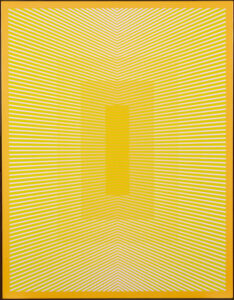
Richard Joseph Anuszkiewicz
American, born 1930
Converging Yellow Green, 1980
Acrylic on canvas
Gift of Dr. Jacob Bornstein, 1983. (1983.58)
The lines in this painting look like they are vibrating: this is because the painting’s dense stripes and contrast force your eyes to make constant tiny movements that bring different areas in and out of focus. Richard Anuszkiewicz was one of the founders of Op Art, a movement in which artists deliberately created optical illusions in their work. Many of his paintings use intense color and nesting shapes to play with viewers’ perception, creating art that is more about the experience of seeing than the painting itself.
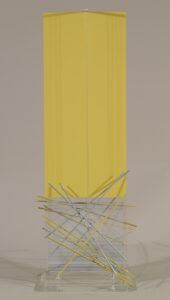
Jésus Rafael Soto
Venezuelan, 1923–2005
Multiple II from Jai-Alai, 1969
Plexiglas, wood, metal, nylon string, edition: 300
Gift of James W. Dye, 1979. (1979.56.6)
When you look at or walk around this multiple from Jai-Alai, the work looks like it is pulsing or rippling. Jésus Rafael Soto was fascinated by the idea of movement, which he believed was the next innovation for art to explore. This work not only has the appearance of motion, it also encourages viewers to move around the gallery to better examine it. Soto liked to use optical illusion with the goal of drawing focus away from the artwork itself and toward concepts like movement and time.
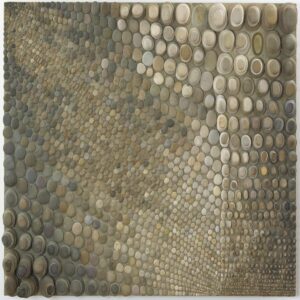
Mary Bauermeister
German, 1934–2023, active in United States 1962–1972
Untitled, 1965
River pebbles on fabric-covered panel
Gift of Carolyn Phillips Minskoff, 1991. (1991.20.1)
Bauermeister glued river rocks and pebbles onto this panel and added comments that question the relationship between art and nature. At upper right, she even labels a painted group of rocks “art,” forcing attention to how this work blurs lines between artwork and found object. Her notes invite us to understand her process, which is as much about ideas as the finished product.
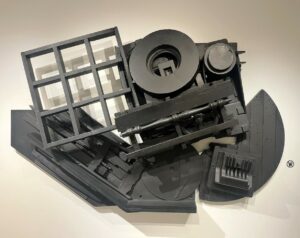
Louise Nevelson
American, 1899–1987
Mirror Shadow XXIV, 1986
Wood
RoBe Collection
Louise Nevelson foraged for the wood for her sculptures on the streets and loading docks of New York City. With attention to pattern, space, and balance, she looked past the everyday functions of objects such as window frames and banisters to use them as aesthetic elements. Her ability to transform such objects into imposing works of art made her one of the most significant sculptors of the twentieth century.
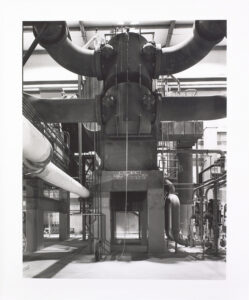
Carol Front
American, born 1940
Untitled from the Power Making series, 2000–2003
Gelatin silver print
Purchase: General Acquisitions Fund, 2003. (2003.28)
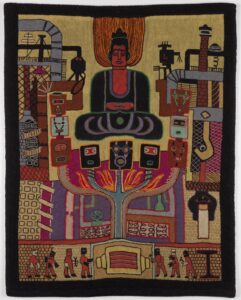
Mildred T. Johnstone, with Pablo Burchard and Joseph Cantieni
American artist, 1900–1988
Primitive Mysteries (or Buddha in a Blast Furnace), 1951
Linen plain weave with wool embroidery
Gift of Mildred T. Johnstone, 1977. (1977.19.3)
In this needlepoint, Johnstone depicts a serene Buddha sitting above a fiery steel mill. This unusual juxtaposition reflects her interest in Eastern spirituality, as well as her experiences visiting Bethlehem Steel.
Witnessing the steelmaking process had a profound impact on Johnstone. She interpreted the metal’s transformation as a metaphor for allowing oneself to be shaped by life’s forces, rather than resisting change—an interpretation that resembles the Buddhist principle of nonattachment.
Although Johnstone’s title for this work perpetuates the damaging idea that non-Western cultures are “primitive,” her interest in Zen Buddhism was sincere: it became a key element of her spiritual and artistic practice by the 1970s.
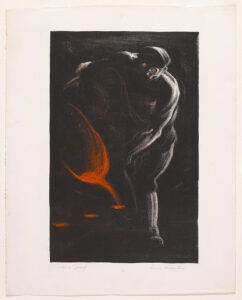
Lewis William Rubenstein
American, 1908–2003
The Foundry, ca. 1940
Lithograph
Purchase: SOTA Print Fund, 1995. (1995.27.3)
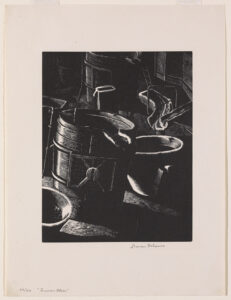
Stevan Dohanos
American, 1907–1994
Furnace Floor, 1933
Wood engraving, edition: 50
Purchase: SOTA Print Fund, 1995. (1995.27.1)
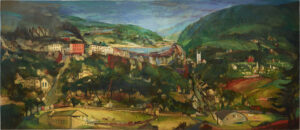
Franz Kline
American, 1910–1962
Lehighton, 1945
Oil on canvas
Purchase: Leigh Schadt and Edwin Schadt Art Museum Trust Fund, 2016. (2016.12)
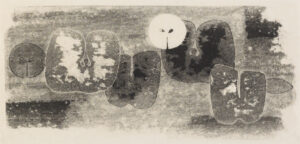
Harry Bertoia
American, 1915–1978
Untitled, ca. 1970s
Monotype on rice paper
Purchase: SOTA Print Fund, 1992. (1992.5.17)
Harry Bertoia made monotypes at least once a week throughout his career. Many of his prints explore ideas about space and form related to his sculptures.
Bertoia had to be slow and careful when making his metal sculptures, but he could work quickly and spontaneously with his prints. He explained, “To do one, then the other, is refreshing and stimulating, and one medium can do what the other could not. Yet at times they merge into a single image.”

Harry Bertoia
American, 1915–1978
Tonal, ca. 1969
Copper and brass
Gift of Brigitta Bertoia, 1981. (1981.34)
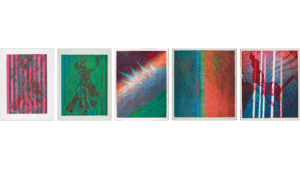
Stanley William Hayter
English, 1901–1988
Rideau (Curtain), 1976–77
Engraving, etching, and soft-ground etching, edition: 75
Rideau (Curtain) (color variant), 1976–77
Engraving, etching, and soft-ground etching, edition: 30
Fastnet, 1985
Engraving, soft-ground etching, and scorper, edition: 50
La Pendu, 1983
Engraving, soft-ground etching, and scorper, edition: 50
Indoor Swimmer, 1981
Engraving and soft-ground etching, edition: 50
Printer: Hector Saunier, Atelier 17, Paris, France
Gift of Paul K. Kania, 2014. (2014.08.19), Purchase: Gift of Paul K. Kania, 2017–2021. (2021.3.1, 2017.20.2, 2018.21.1, 2019.8.4)
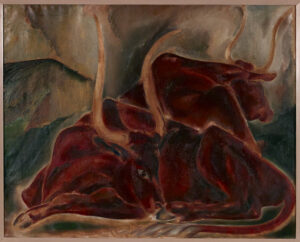
Elsie Driggs
American, 1898–1992
Oxen, 1926
Oil on canvas
Purchase: The Reverend and Mrs. Van S. Merle-Smith Jr. Endowment Fund, 1998. (1998.18)
Elsie Driggs is often associated with the Precisionists, a group of American artists who in the 1920s depicted the industrialization and the modernization taking place across a rapidly changing American landscape using precise lines and crisp geometric shapes. Here, however, Driggs finds formal beauty in two oxen, reveling in the rhythmically undulating forms of the animals and the surrounding mountains.
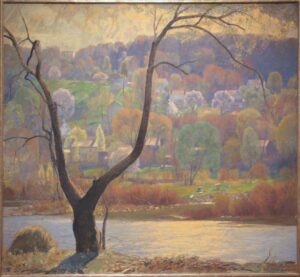
Daniel Garber
American, 1880–1958
Springtime, Tohickon, 1936
Oil on canvas
Partial gift by Anonymous Donor
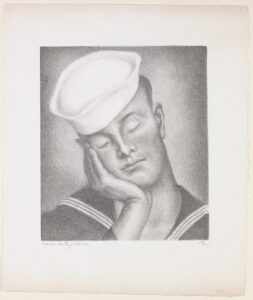
Julius Thiengen Bloch
American, 1888–1966
Sailor Resting, early to mid-1900s
Lithograph, edition: 30
Gift of Estate of Julius Bloch, 1967. (1967.39)
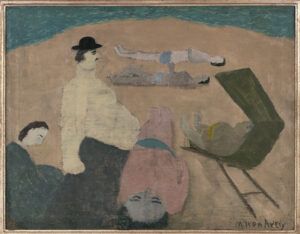
Milton Avery
American, 1893–1965
Coney Island, 1933
Oil on canvas
Gift of Milton Avery Trust, 1994. (1994.20)
This painting by Milton Avery—one of the most influential American artists of the twentieth century—represents the convergence of two major trends in art of the 1930s: social realism and modernism. The former is evident in Avery’s depiction of an ordinary scene at Coney Island, a beach popular at the time with working-class New Yorkers looking to escape the summer heat. Avery’s modernist treatment of his subject includes the painting’s tilted perspective, flattened forms, and multiple focal points.
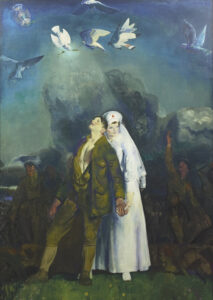
George Bellows
American, 1882–1925
Dawn of Peace, 1918
Oil on canvas
Purchase: Gift of Estelle Reninger, 1990. (1990.15)
Motivated by a patriotic response to alleged German atrocities during World War I, George Bellows spent more than eight months on this painting. It belongs to a series of at least fifty related works that he created about wartime themes. Bellows probably found inspiration for Dawn of Peace in idealized popular illustrations of Red Cross nurses―the new heroines of the era.
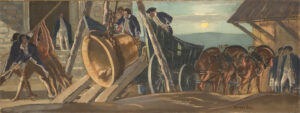
Gifford Reynolds Beal
American, 1879–1956
Hiding the Liberty Bell in Allentown, Pennsylvania, 1938
Oil on Masonite
Gift of the Family of Gifford Beal, 2006. (2006.9)
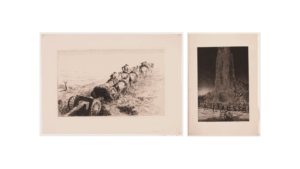
Kerr Eby
American, born Japan, 1889–1946
Far left: In the Open, 1927
Etching and sandpaper ground, edition: 90
Left: The Caissons Go Rolling Along, 1929
Etching, edition: 90
Printer: the artist
Gift of the Reverend and Mrs. Van S. Merle-Smith, Jr.,
(1976.27.10, 14)
Kerr Eby served in France during World War I, making sketches in his spare time. Upon his return home, he translated his drawings and memories into powerful prints, like these two illustrating weary soldiers on the move. Eby’s work focused on capturing the reality of a conflict still in recent memory—unlike the 1938 painting at left, which offers a bright and heroic rendering of a Revolutionary War scene.
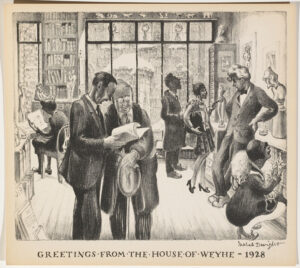
Mabel Dwight
American, 1876–1955
Greetings from the House of Weyhe, 1928
Lithograph, edition: 2000
Printer: George C. Miller, New York, NY
Publisher: Weyhe Gallery, New York, NY
Purchase: SOTA Print Fund, 2005. (2005.20)
The Weyhe Gallery opened on Lexington Avenue in New York City in 1919, and was an art world hub throughout the 1920s and 30s. The gallery specialized in prints and drawings, and sent out a holiday card designed by one of the artists they represented each year. Scenes ranged from traditional and seasonal to modernist, and often featured the shop’s distinctive façade. Mabel Dwight’s lithograph shows the interior, with gallery founder Erhard Weyhe, curator Carl Zigrosser, and artist Wanda Gág.
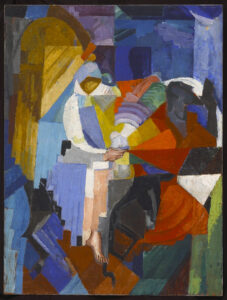
James Henry Daugherty
American, 1889–1974
Flight Into Egypt, ca. 1920
Oil on canvas
Purchase: General Acquisition Fund, 2001. (2001.4)
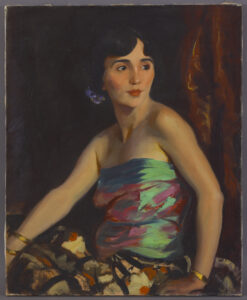
Robert Henri
American, 1865–1929
Isolina Maldonado—Spanish Dancer, 1921
Oil on canvas
Gift of Dr. and Mrs. John Altobelli, 1996. (1996.27)
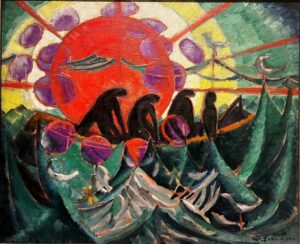
William Zorach
American, 1887–1966
Hauling the Weir—Provincetown, 1916
Oil on canvas
Private Collection
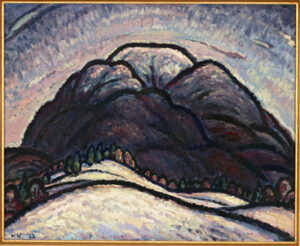
Harold Weston
American, 1894–1972
Giant Winter, 1922
Oil on canvas
Purchase: The Reverend and Mrs. Van S. Merle-Smith Jr. Endowment Fund, 1987. (1987.8)
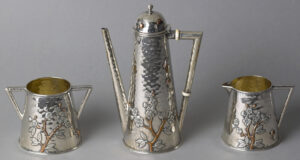
Whiting Manufacturing Company
American silver manufacturer, 1866–1924
Coffee Set, ca. 1880
Sterling Silver, copper, and ivory
Purchase: Gift of Edith M. Merkle in memory of Dr. Ralph Merkle, 2003. (2003.7.1.)
The asymmetrical arrangements of flowers and insects on this coffee service, as well as the use of mixed metals (as in the Japanese vase shown here), demonstrate the influence of Japanese art on American silver designers in the 1870s and 1880s.
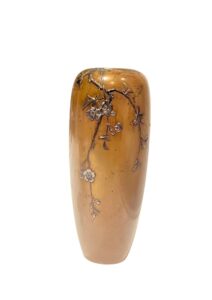
Yoshitsugu
Japanese, active late 1800s
Nogawa Company, manufacturer
Japanese, est. 1825
Vase with Tree Branch Motif
Mixed metal inlay
Gift of Mr. and Mrs. Herman Finkelstein, 1967. (1967.177.1)
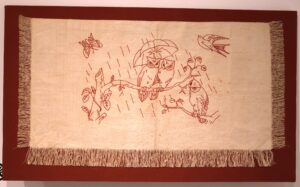
American
Splasher, late 1800s
Cotton with cotton embroidery
Gift from the Collection of Rosalind and Edwin Miller, 2000. (2000.27.58)
In addition to bedcovers like the one behind you, women also used outline embroidery to decorate other household textiles. This splasher would have hung on the wall behind a sink or washstand, and features a thematically appropriate rainy scene.
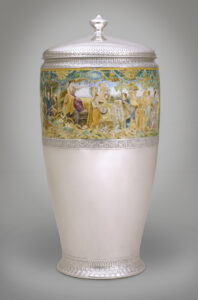
Louis Comfort Tiffany
American, 1848–1933
Tiffany & Company, manufacturer
New York, NY, 1837–present
Albert A. Southwick, designer
Presentation Vase with Cover, ca. 1915
Sterling silver with Limoges porcelain enamel decoration
Gift of Bethlehem Steel Co., 1985. (1985.25a, b)
Louis Comfort Tiffany was the son of Charles Lewis Tiffany, the famous jeweler and founder of Tiffany & Company. He started his career as a painter, becoming the firm’s chief designer after his father’s death in 1902. This vase reproduces, in enamel, two Louis Comfort Tiffany paintings representing the Roman goddesses Flora and Ceres, and their retinues. The enamel was thinly applied, allowing the engraved sketch to show through.
Tiffany & Company had participated in every world’s fair since the Paris Exposition of 1855, and thus gained an international reputation. This urn was created as a demonstration piece for San Francisco’s Panama-Pacific Exposition. It showcases the quality and sumptuousness of Tiffany products, in order to entice clients to place orders. In 1922, it was presented to Charles M. Schwab, chairperson of Bethlehem Steel, on the occasion of his sixtieth birthday.
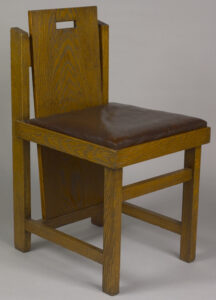
Frank Lloyd Wright
American, 1867–1959
Side Chair, ca. 1903
Oak and leather
Gift of Deborah S. Haight, 1997. (1997.6)
Frank Lloyd Wright designed this chair for a house he built for the Little family in Peoria, Illinois. When the Littles moved to Minnesota and had Wright design another house for them, they brought some of the furniture with them. This chair may, in fact, have been used in the library you see through this window, which is from the Little’s Minnesota home.
Unlike other progressive designers of his era, Wright drew inspiration from machine production. In this rectilinear chair, he makes obvious use of plain, machine-produced boards. The simplicity of his design highlights the beautiful arrowhead shapes in the wood’s grain, which can be seen on the chair back.
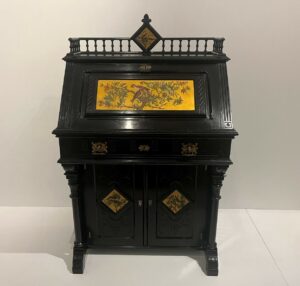
Attributed to Allen and Brother
Philadelphia, PA, active 1835–1896
Aesthetic Movement Desk,
1875–1880
American cherry, maple, and walnut; gilt and painted slate tiles
Purchase: Gift of Edith M. Merkle in Memory of Dr. Ralph Merkle, 2005. (2005.26)
This desk achieves an “artistic” look by evoking Japanese lacquer—with a little Gothic-inspired carving added for good measure. To mimic lacquer’s dark polish, the manufacturer treated the desk’s wood with iron acetate: this created a chemical reaction called ebonizing that colored the wood black. The desk’s gold panels with nature scenes echo lacquerware’s decorated surfaces.
Members of the Aesthetic movement valued beautiful furniture because they believed an attractive home would improve everyday life.
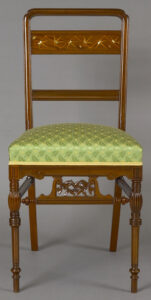
American or European
Side Chair, ca. 1880
Mahogany with mother-of-pearl, metal, and wood marquetry
Purchase: Gift of the King Family and General Acquisitions Fund, 2004. (2004.16.1)
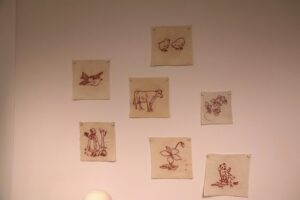
Woerner Family Member
Redwork Squares, early
1900s
Cotton with cotton embroidery
Gift of the Estate of Arline Woerner Hunsicker, 2008.
(2008.15.11.3, 8, 10, 13, 21, 24, 27, 32)
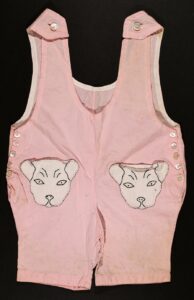
Probably Canadian
Child’s Overalls, late 1800s – early 1900s
Cotton with applique and stem stitch, blanket stitch, and whipstitch embroidery
Gift of Harriet Werner, 2021 (2021.19.2)
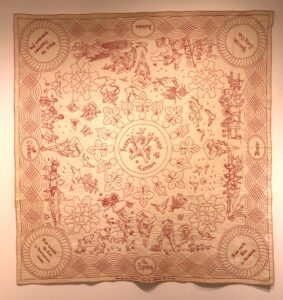
Max Johannes, designer
American, born Germany, 1856–1918
Four Seasons Redwork, 1909
Embroidered and quilted cotton
Collection of Arlan and Pat Christ.
Inscription: “Drawn by Max Johannes. 211 Locust St. Allentown Pa. A.D. 1909.”
Allentown resident Max Johannes created the unique design for this embroidered quilt, proudly including his name at the lower edge. One source of inspiration was the Ivory Soap sign pictured below: can you spot how he used it here?
This style of outline embroidery was quite popular at the turn of the twentieth century, but Johannes’s large-scale design is unusual. Typically, people making bedcovers in this technique would have assembled small embroidered squares like the ones at left.
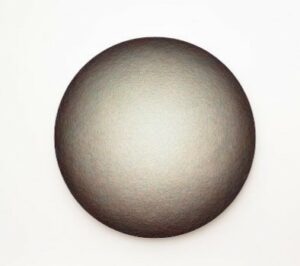
Emil Lukas
American, born 1964
Expander, 2020
Thread over wood frame with plaster, paint, and nails
Purchase: The Estelle Reninger Fund, 2022. (2022.1)
You may have noticed Emil Lukas’s “thread painting” Expander appearing to change as you approached it. Using simple materials to create a complex piece, the artist wrapped variously colored threads in painstaking fashion around a frame, producing an illusory depth and aura that deceives the eye. Lukas, who is based in northeastern Pennsylvania, works improvisationally but with intention. Every decision—the placement of a single thread a fraction of an inch one way or another, the color of that thread, and the layering—contributes to the overall effect on the viewer’s perception.
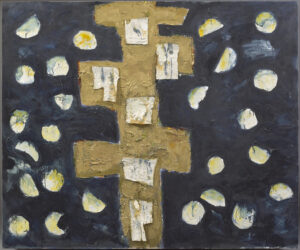
Joan Snyder
American, born 1940
Moon Theater, 1986
Oil, acrylic and linen on canvas
Purchase: Gift of Sam Spektor and Ann Berman in Honor of Bernard Berman, 1989. (1989.42)
Moon Theater presents not one moon but a bounty of twenty-six. These are scattered around a stylized tree/crucifix form, a recurrent motif in Snyder’s work that symbolizes life and death. Snyder’s emotional paintings challenged the impersonal nature of male-led art movements like Minimalism, and made her an influential feminist artist. She explained, “Making art is, for me, practicing a religion. … My work is my pride, creates for me a heritage. It is a place to struggle freely at my altar.”
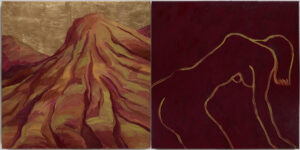
Kay WalkingStick
American, born 1935
Blame the Mountains III, 1998
Oil and brass leaf on canvas (left panel); oil on canvas (right panel)
Gift of David Echols, 2011. (2011.11a, b)
In this painting, the sensual curves of the female figure complement the rugged mountains. Kay WalkingStick’s series Blame the Mountains was inspired by the end of a romantic relationship during a trip to the Dolomites, a mountain range of northern Italy.
An important component of Easton-based WalkingStick’s identity is her Cherokee and Scottish-Irish heritage. She likes to create diptychs—artworks with separate panels that are joined together—which she states are “particularly attractive to those of us who are biracial.”

